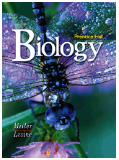BIOLOGY
by Miller & Levine
[complete Table of Contents]

|
Use the pull-down menu to jump to any of the Book's 40 Chapters: |
Additional Resources:

American rubyspot [Hetaerina
americana] from "The
Damselflies of Texas."
![]() Chapter 28
Chapter 28![]()
Arthropods and Echinoderms
In this chapter, students will read about the general characteristics and major types of arthropods and echinoderms, with special emphasis on insects. The links below lead to additional resources to help you with this chapter. These include Hot Links to Web sites related to the topics in this chapter, the Take It to the Net activities referred to in your textbook, a Self-Test you can use to test your knowledge of this chapter, and Teaching Links that instructors may find useful for their students.
| Hot Links | Chapter Self-Test |
| Take it to the Net | Teaching Links |
What are Web Codes? |
Web
Codes for Chapter 28: |
![]()
Section
28-1: Introduction to the Arthropods
![]() Arthropods have
a segmented body, a tough exoskeleton, and jointed appendages.
Arthropods have
a segmented body, a tough exoskeleton, and jointed appendages.
![]() In many groups
of arthropods, continuing evolution has led to fewer body segments and
highly specialized appendages for feeding, movement, and other functions.
In many groups
of arthropods, continuing evolution has led to fewer body segments and
highly specialized appendages for feeding, movement, and other functions.
![]() When they outgrow
their exoskeletons, arthropods undergo periods of molting.
When they outgrow
their exoskeletons, arthropods undergo periods of molting.
Section
28-2: Groups of Arthropods
![]() Arthropods are
classified based on the number and structure of their body segments and
appendages, particularly their mouthparts.
Arthropods are
classified based on the number and structure of their body segments and
appendages, particularly their mouthparts.
![]() Crustaceans typically
have two pairs of branched antennae, two or three body sections, and chewing
mouthparts called mandibles.
Crustaceans typically
have two pairs of branched antennae, two or three body sections, and chewing
mouthparts called mandibles.
![]() Chelicerates have
mouthparts called chelicerae and two body sections, and most have four
pairs of walking legs.
Chelicerates have
mouthparts called chelicerae and two body sections, and most have four
pairs of walking legs.
![]() Uniramians have
jaws, one pair of antennae, and unbranched appendages.
Uniramians have
jaws, one pair of antennae, and unbranched appendages.
Section
28-3: Insects
![]() Insects have a
body divided into three parts—head, thorax, and abdomen. Three pairs
of legs are attached to the thorax.
Insects have a
body divided into three parts—head, thorax, and abdomen. Three pairs
of legs are attached to the thorax.
![]() The growth and
development of insects usually involve metamorphosis, which is a process
of changing shape and form. Insects undergo either incomplete metamorphosis
or complete metamorphosis.
The growth and
development of insects usually involve metamorphosis, which is a process
of changing shape and form. Insects undergo either incomplete metamorphosis
or complete metamorphosis.
![]() Ants, bees, termites,
and some of their relatives form complex associations called societies.
Ants, bees, termites,
and some of their relatives form complex associations called societies.
Section
28-4: Echinoderms
![]() Echinoderms are
characterized by spiny skin, five-part radial symmetry, an internal skeleton,
a water vascular system, and suction-cup-like structures called tube feet.
Echinoderms are
characterized by spiny skin, five-part radial symmetry, an internal skeleton,
a water vascular system, and suction-cup-like structures called tube feet.
![]() The water vascular
system carries out many essential body functions in echinoderms, including
respiration, circulation, and movement.
The water vascular
system carries out many essential body functions in echinoderms, including
respiration, circulation, and movement.
![]() Classes of echinoderms
include sea lilies and feather stars, sea stars, brittle stars, sea urchins
and sand dollars, and sea cucumbers.
Classes of echinoderms
include sea lilies and feather stars, sea stars, brittle stars, sea urchins
and sand dollars, and sea cucumbers.